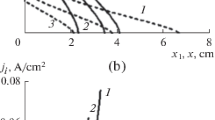Abstract
The article proposes an iterative technique of calculation of energetic efficiency of triode high voltage glow discharge electron sources’, based on taking into account the influence of heating of anode plasma by the accelerated electrons of electron beam and by the slow secondary discharge electrons, reflected from the anode. The increase of temperature of anode plasma influences its’ volume, as well as the concentration and mobility of ions’ in it. Therefore, the proposed model allows obtaining the corrected values of discharge current and energetic efficiency of electron sources by taking into account the thermodynamic parameters of anode plasma. In addition, one of the advantages of proposed iterative calculation technique is that the model is closed and self-consistent, therefore, it does not demand use of approximated data about the thermodynamic parameters of discharge plasma from references.
Similar content being viewed by others
References
S. V. Ladokhin, N. I. Levitsky, V. B. Chernyavsky, et al., Electron Beam Melting in Foundry [in Russian] (Stal, Kiev, 2007).
M. A. Zavyalov, Yu. E. Kreindel, A. A. Novikov, L. P. Shanturin, Plasma Processes in Technological Electron Guns [in Russian] (Energoizdat, Moscow, 1989).
M. I. Grechanyuk, A. G. Melnyk, I. M. Grechanyuk, V. G. Melnyk, D. V. Kovalchuk, “Modern electron beam technologies and equipment for melting and physical vapor deposition of different materials,” Elektrotechnica and Electronica 49, No. 5-6, 115 (2014). URL: http://epluse.fnts.bg/EplusE/EplusE-abstracts-20 14-05-06.pdf.
G. Mattausch, B. Zimmermann, F. Fietzke, J. P. Heinss, B. Graffel, F. Winkler, F. H. Roegner, C. Metzner, “Gas discharge electron sources—proven and novel tools for thin-film technologies,” Elektrotechnica and Electronica 49, No. 5-6, 183 (2014). URL: http://epluse.fnts.bg/EplusE/EplusE-abstracts-201 4-05-06.pdf.
P. Feinaeugle, G. Mattausch, S. Schmidt, F.-H. Roegner, “A new generation of plasma-based electron beam sources with high power density as a novel tool for high-rate PVD,” Proc. of 54-th Annual Tech. Conf. on Society of Vacuum Coaters (Chicago, 2011), pp. 202–209.
D. Yarmolich, P. Nozar, S. Gleizer, Y. E. Krasik, G. Mittica, C. Ancora, A. Brilliante, I. Bilotti, C. Taliani, “Characterization of deposited films and the electron beam generated in the pulsed plasma deposition gun,” Japan. J. Applied Physics 50, No. 8S1 (2011). DOI: 10.1143/JJAP.50.08JD03.
G. Mattausch, B. Scheffel, O. Zywitzki, C. Metzner, F. H. Roegner, “Technologies and tools for the plasma-activated EB high-rate deposition of Zirconia,” Elektrotechnica and Electronica 47, No. 5-6, 152 (2012). URL: http://epluse.fnts.bg/EplusE/EplusE-abstracts-2012-05-06.pdf.
S. V. Denbnovetsky, V. I. Melnyk, I. V. Melnyk, B. A. Tugay, “Model of control of glow discharge electron gun current for microelectronics production applications,” Proc. SPIE 5065, 64 (2003). DOI: 10.1117/ 12.502174.
Z. Schiller, U. Gaizig, Z. Panzer, Electron-Beam Technology [in Russian] (Energiya, Moscow, 1980).
N. N. Rykalin, I. V. Zuev, A. A. Uglov, Fundamentals of Electron-Beam Processing of Materials (Mashinostroyeniye, Moscow, 1978).
N. Grechanyuk, P. Kucherenko, I. Grechanyuk, P. Shpack, “Modern technologies and equipment for obtaining of new materials and coatings,” Elektrotechnica and Electronica 41, No. 5-6, 122 (2006).
S. V. Denbnovetsky, V. I. Melnik, I. V. Melnik, B. A. Tugay, “Investigation of forming of electron beam in glow discharge electron guns with additional electrode,” Proc. of XVIII Int. Symp. on Discharges and Electrical Insulation in Vacuum, 17–21 Aug. 1998, Eindhoven, The Netherlands (IEEE, 1998), Vol. 2, pp. 637–640. DOI: 10.1109/DEIV.1998.738827.
I. V. Melnyk, “Investigation of the dependence of energetic efficiency of triode high voltage glow discharge electron sources on its parameters and geometric dimensions of electrode system,” Elektronnoe Modelirovanie 35, No. 5, 71 (2013). URL: http://www.emodel.org.ua/index.php/en/30-archive/2013-ãîä/35-5/ 536-35-5-6-e.html.
I. V. Melnyk, “Estimating of current rise time of glow discharge in triode electrode system in case of control pulsing,” Radioelectron. Commun. Syst. 56, No. 12, 592 (2013). DOI: 10.3103/S0735272713120066.
V. L. Granovskii, Electric Current in Gases. Vol. 1: General Problems of Electrodynamics of Gases [in Russian] (GITTL, Moscow, 1952).
Yu. P. Raizer, Gas Discharge Physics (Springer Berlin Heidelberg, Berlin, 2011).
E. P. Velikhov, B. S. Kovalev, A. T. Rakhimov, Physical Phenomena in a Gas-Discharge Plasma [in Russian] (Nauka, Moscow, 1987).
O. A. Sinkevich, I. P. Stakhanov, Plasma Physics. Stationary Processes in Partly Ionized Gas [in Russian] (Vyssh. Shkola, Moscow, 1991).
V. P. Ilyin, Numerical Methods for Solving Problems in Electrophysics [in Russian] (Nauka, Moscow, 1985).
F. P. Vasiliev, Numerical Methods for Solving Extremal Problems [in Russian] (Nauka-GRFML, Moscow, 1988).
A. A. Novikov, High Voltage Glow Discharge Electron Sources with Anode Plasma [in Russian] (Energoatomizdat, Moscow, 1983).
I. V. Melnyk and S. B. Tugay, “Analytical calculations of anode plasma position in high-voltage discharge range in case of auxiliary discharge firing,”Radioelectron. Commun. Syst. 55, No. 11, 514 (2012). DOI: 10.3103/ S0735272712110064.
Author information
Authors and Affiliations
Corresponding author
Additional information
Original Russian Text © I.V. Melnyk, 2017, published in Izvestiya Vysshikh Uchebnykh Zavedenii, Radioelektronika, 2017, Vol. 60, No. 7, pp. 413–424.
About this article
Cite this article
Melnyk, I.V. Simulation of energetic efficiency of triode high voltage glow discharge electron sources with account of temperature of electrons and its mobility in anode plasma. Radioelectron.Commun.Syst. 60, 319–329 (2017). https://doi.org/10.3103/S0735272717070056
Revised:
Published:
Issue Date:
DOI: https://doi.org/10.3103/S0735272717070056




